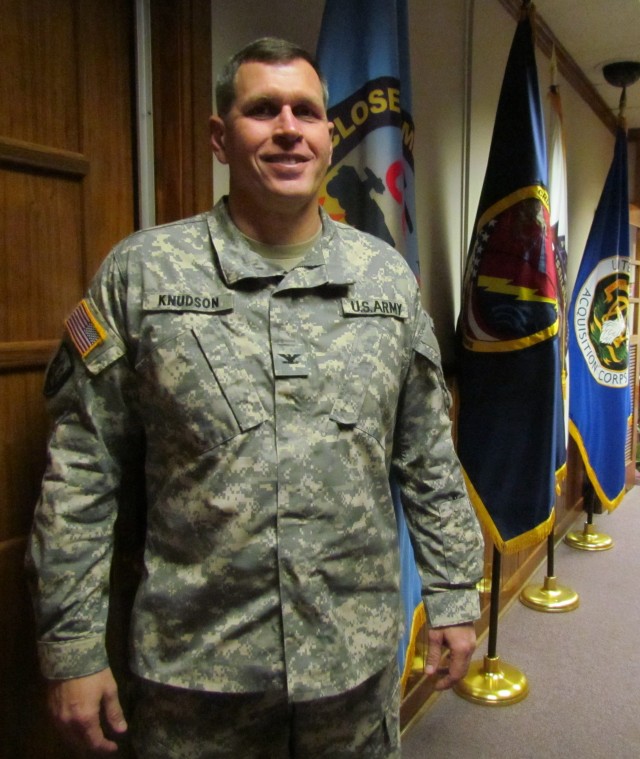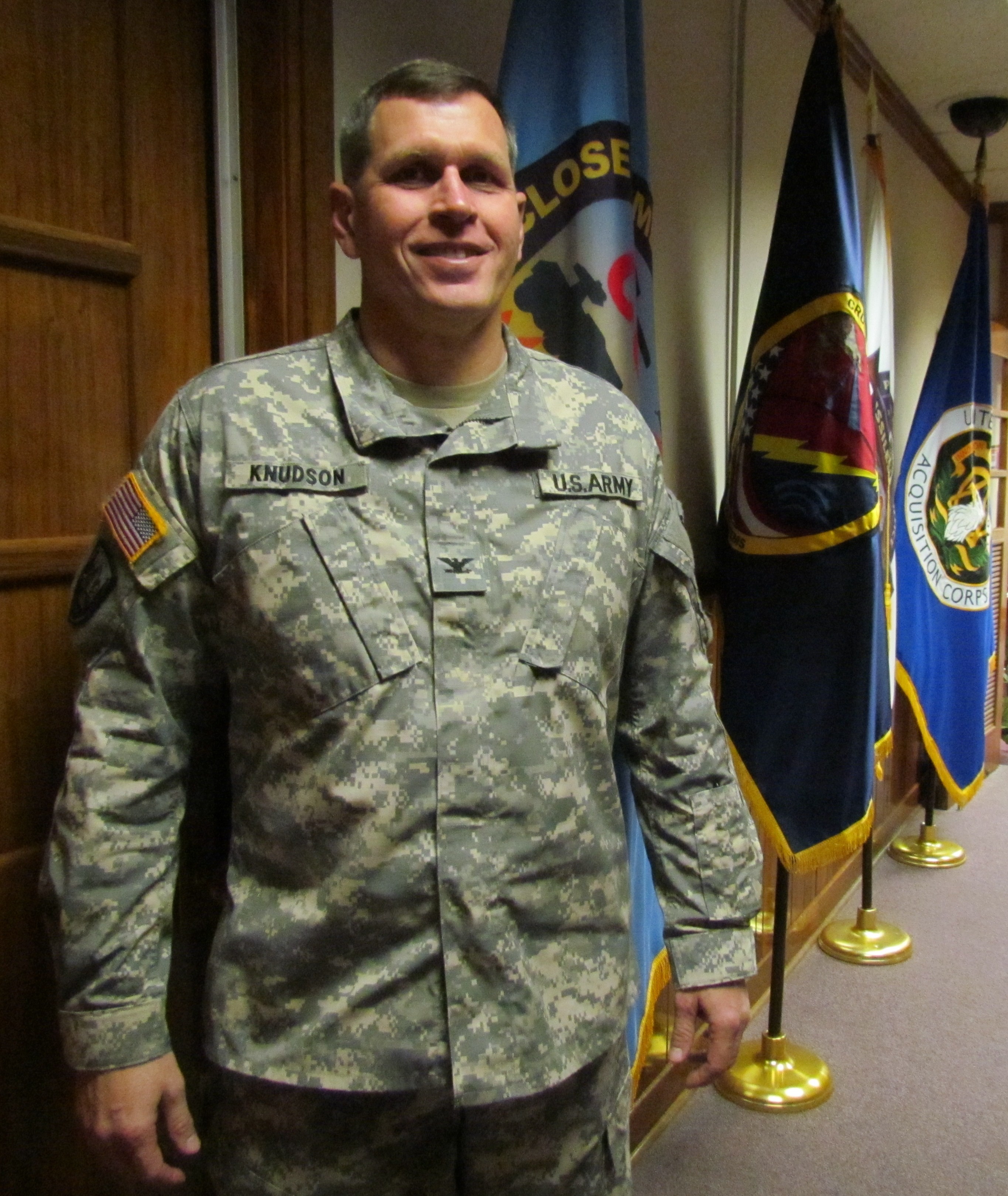REDSTONE ARSENAL, Ala. -- On Feb. 4, Col. Ole Knudson, the program executive officer for missiles and space, will donned the one-star insignia of a brigadier general.
This major career milestone will be a time for celebrating for Knudson, his wife Elizabeth and their family, with about 40 of his relatives making the trip to Redstone Arsenal to see the Feb. 4 ceremony in Bob Jones Auditorium. To make it even more prestigious, the ceremony will be officiated by Lt. Gen. Bill Phillips, principal military deputy assistant secretary of the Army for acquisition, logistics and technology and director of acquisition career management.
Though reaching general status is indeed a high point in the career of any Army officer, this longtime Soldier knows that the new star on his uniform does not signify an ending in his aspirations as an Army leader. What it represents is yet another step in learning and leading an Army organization known for providing war fighters with the best in missile and air defense capabilities.
"This PEO has a very capable work force," Knudson said. "It is a sizable work force that includes employees from the AMRDEC (Aviation and Missile Research Development and Engineering Center) and AMCOM (Aviation and Missile Command) as well as contractors.
"There's a lot of learning that I need to do, particularly with some of the air defense related systems. They are relatively complex systems doing some really challenging things. They are inherently complex in the integration of these systems. There's a big learning curve and I've had a lot of help so far with that."
PEO for Missiles and Space is an organization of more than 1,000 Soldier, civilian and contractor employees, eight project offices and a $3 billion annual budget with an additional $1 million in foreign military sales. Its systems are used in more than 35 countries.
Knudson was named the PEO for missiles and space in October 2010, following a deployment that took him to Iraq from August 2009 to January 2010 as the director for the assistant secretary of the Army for Acquisition, Logistics and Technology Operation Forward and then to Afghanistan from February to August 2010 as the deputy director for the Security Assistance Office Afghanistan.
Though he has had to wait a few months while congressional approvals were obtained for his promotion to general, Knudson has wasted no time becoming familiar with the programs that are part of his new assignment. His own experience makes this West Point graduate qualified for the job at hand at PEO for Missiles and Space.
"I've been working in the acquisition and modernization of equipment field for about 20 years now," he said.
"I've had a number of assignments involving all phases of program concept, technology, engineering and planning, production, fielding and sustainment. I've been directly involved in all phases of several programs. I've worked on ground vehicle systems, very large software programs and guided munitions. I have a lot of experience with munitions in general and with warheads."
He has also been involved with several intelligence programs and foreign military sales programs.
Knudson's military career has included serving as project manager for Combat Ammunition Systems within the PEO for Ammunition from 2005-09, and as the director for plans, programs and resources within the Office of the Assistant Secretary of the Army for Acquisition, Logistics and Technology. He has also had assignments as the system coordinator for Multiple Launch Rocket System, Guided MLRS and HIMARS -- three systems that are today part of PEO for Missiles and Space.
During those years, his work brought him to Redstone Arsenal from time to time.
"Everybody that is in the materiel development acquisition process knows about Redstone Arsenal," he said. "There's a lot that goes on here. There are tremendous capabilities here and a very capable work force. In the late '90s, when I was system coordinator for the MLRS program, I came here to work with the then PEO for Tactical Missiles. There are some people from that time who are still here."
Knudson also has familiarity with the operational side of the PEO's missiles, including operational experience with MLRS.
But Knudson also knows that to remain relevant to the war fighter, the missiles and air defense systems of PEO for Missiles and Space must evolve and improve. New systems and the integration of systems, such as the Integrated Air and Missile Defense Battle Command System, are essential to giving Soldiers in the field more capabilities. The organization must build on the success of Hellfire, HIMARS, Guided MLRS, ATACMS, Javelin, TOW and ITAS, Sentinel, Stinger, Avenger and Patriot, and expand to include such new systems as the C-RAM, JLENS, the Joint Air to Ground Missile and IBCS for integrated missile defense.
"Our future capabilities will be in response to urgent needs," he said. "We are virtually working on service life extensions or improvement programs on most of our existing systems. We have a very substantial effort of improvement for all of our systems. We are focused on continuing our efforts in developing new and better capabilities.
"We are modernizing our systems and better integrating them for the war fighter and making them more affordable so that we can afford to provide all the capabilities that war fighters need and not have the gaps that are unfunded."
Integrating systems and making them easier to use have a multiplier effect for the war fighter, he added.
PEO for Missiles and Space has been effective in its mission because of the positive working relationship with AMCOM, AMRDEC and its industry partners.
"There has been a very cooperative approach from all of the leadership," Knudson said. "There are no organizational barriers to working together on a mission or a problem."
As any Army leader, Knudson hopes to lead in a way that encourages and motivates employees focused on the mission.
"For the civilian and Soldier work force here, I expect that we do our best every day in providing the best capabilities for our war fighter and in the most affordable way," he said. "We've set the bar high. We should strive to do our best at being better effectively and efficiently as we tackle hard and complex problems."
Toward that end, Knudson expects those employees to work together, regardless of which organization they represent, or whether they represent government, industry or an international partner.
"This is a big team effort made up of very competent individuals and subject matter experts," he said. "I expect them to work together fairly and respectfully, and to work in a competent manner. This is a great team to be part of."


Social Sharing